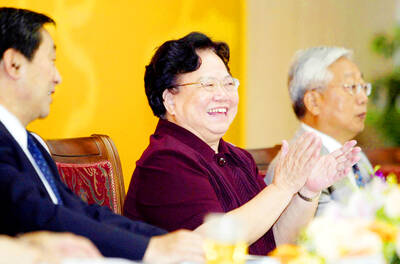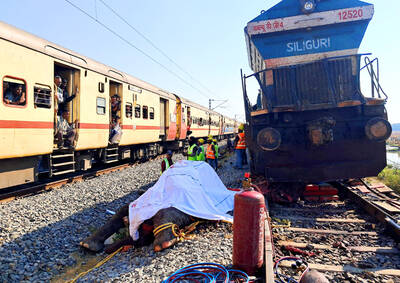When the wind blows in one Shanghai suburb, residents can smell the stench rising from a towering garbage dump, feared to be so harmful it can make people vomit and cause birth defects.
Now residents of Songjiang District are raising a stink about the future of the landfill, one of a series of recent protests across China as people hold the government more accountable for health and environmental problems.
“All the garbage in Songjiang comes here,” said Chen Chunhui, who grew up nearby.
“This is a residential district, so people are making a fuss. They say if you smell it, your baby will be a freak,” he added.
Hundreds took to the streets in late May and dozens again early last month to oppose the landfill and a planned garbage incinerator, which officials had proposed to solve the festering problem.
The May protest is believed to be Shanghai’s largest since 2008, when hundreds marched against an extension of the city’s high-speed “maglev” train line, prompting the government to suspend the project indefinitely.
The Songjiang protesters — who are largely young, educated and not necessarily Shanghai natives — claim the incinerator would spew dangerous toxins and slammed the local government’s lack of transparency on the project.
Government officials announced in May that Songjiang would build the 250 million yuan (US$40 million) incinerator on its current -landfill site as the population swells.
However, residents claim the incinerator could affect the health of hundreds of thousands of people and called for the landfill, which towers up to 17m and covers an area the size of a football field, to be moved.
Environmental pollution and perceived health threats are sparking protests elsewhere in China, helped by social media which allows organizers to publicize their causes and rally others despite tight government control.
Last year, thousands of protesters halted production at a polluting solar panel factory in the eastern city of Haining, while residents in the northeastern city of Dalian stopped a planned petrochemical plant.
Earlier this month in Sichuan Province, hundreds of protesters clashed with police over a planned metals plant in Shifang city and forced the project to be scrapped.
“This nascent urban middle class is increasingly unwilling to accept perceived threats to their quality of life, so you are having a greater tendency for people to take to the streets,” said Phelim Kine, senior Asia researcher at New York-based Human Rights Watch.
China had an estimated 180,000 protests in 2010 and the numbers have risen steadily since the 1990s, according to estimates by sociology professor Sun Liping (孫立平) of Tsinghua University in Beijing.
The government has grown more sophisticated in handling them since the 1989 Tiananmen Square crackdown, when soldiers fired on -protesters, Kine said.
However, the government still targets protest leaders, seeking to dissuade them using soft and hard tactics, he added.
In the Songjiang case, Shanghai authorities have allowed the protests to take place, amid a massive police presence, but have not sought to clear away demonstrators with mass detentions.
In the May demonstration, police blocked protesters from marching to the nearby university district, fearing greater student participation.
In the smaller protest last month, organizers held a dialogue with authorities, which allowed the demonstration to take place as long as it remained orderly.
However, local authorities have not yet given any signal of giving in to the protesters.
“Trust us, we will be spending so much money that there’s no reason for us not to make sure it operates properly and safely,” Songjiang sanitation bureau official Xu Qiyong (徐其永) told the state-backed Global Times newspaper.
Trust remains an issue.
“There is no transparency. There is no confidence in the government,” one protester said.

REVENGE: Trump said he had the support of the Syrian government for the strikes, which took place in response to an Islamic State attack on US soldiers last week The US launched large-scale airstrikes on more than 70 targets across Syria, the Pentagon said on Friday, fulfilling US President Donald Trump’s vow to strike back after the killing of two US soldiers. “This is not the beginning of a war — it is a declaration of vengeance,” US Secretary of Defense Pete Hegseth wrote on social media. “Today, we hunted and we killed our enemies. Lots of them. And we will continue.” The US Central Command said that fighter jets, attack helicopters and artillery targeted ISIS infrastructure and weapon sites. “All terrorists who are evil enough to attack Americans are hereby warned

‘POLITICAL LOYALTY’: The move breaks with decades of precedent among US administrations, which have tended to leave career ambassadors in their posts US President Donald Trump’s administration has ordered dozens of US ambassadors to step down, people familiar with the matter said, a precedent-breaking recall that would leave embassies abroad without US Senate-confirmed leadership. The envoys, career diplomats who were almost all named to their jobs under former US president Joe Biden, were told over the phone in the past few days they needed to depart in the next few weeks, the people said. They would not be fired, but finding new roles would be a challenge given that many are far along in their careers and opportunities for senior diplomats can

The death of a former head of China’s one-child policy has been met not by tributes, but by castigation of the abandoned policy on social media this week. State media praised Peng Peiyun (彭珮雲), former head of China’s National Family Planning Commission from 1988 to 1998, as “an outstanding leader” in her work related to women and children. The reaction on Chinese social media to Peng’s death in Beijing on Sunday, just shy of her 96th birthday, was less positive. “Those children who were lost, naked, are waiting for you over there” in the afterlife, one person posted on China’s Sina Weibo platform. China’s

Seven wild Asiatic elephants were killed and a calf was injured when a high-speed passenger train collided with a herd crossing the tracks in India’s northeastern state of Assam early yesterday, local authorities said. The train driver spotted the herd of about 100 elephants and used the emergency brakes, but the train still hit some of the animals, Indian Railways spokesman Kapinjal Kishore Sharma told reporters. Five train coaches and the engine derailed following the impact, but there were no human casualties, Sharma said. Veterinarians carried out autopsies on the dead elephants, which were to be buried later in the day. The accident site